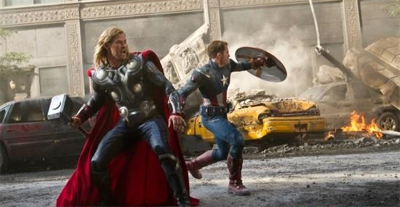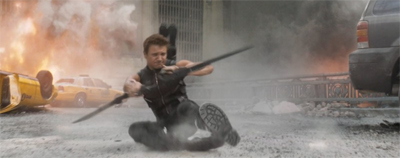I had the chance to watch Chronicle again over the weekend, and I still found it a boldly fascinating (albeit flawed) film. The construction of the movie as a collection of “found footage” still strains more suspension of disbelief than any of the antics involving the lead three characters, but it remains a thoughtful deconstruction and exploration of the superhero tropes and genre that audiences have begun to take for granted. In particular, the movie’s climax – though filmed on a shoestring – still does a better job evoking a sense of scale than Joss Whedon’s admitted stylish last half-hour of The Avengers.
The idea of a superhuman should be an inherently terrifying idea. The notion that somebody could be granted abilities so far superior to those of a regular person seems a plot more befitting a horror than an escapist fantasy. Imagine the destructive capabilities of a person who can control objects with the power of their mind, with impenetrable skin and near unlimited power. It is cool, as at the climax of so many films, to watch these characters knocked around like ragdolls, thrown through walls like tissue paper and leaving a bigger dent in the pavement than they do in each other.
Virtually every superhero film depicts this inevitable third-act clash of the titans with a dispassionate air, creating the impression that our heroes are simply playing childish games in a world constructed entirely of consequence. There’s no sense of what this throw-down means to the people in the crossfire, save for crowd shots of fleeing innocents to establish mood or the odd hostage. In Iron Man 2, the showdown at the Stark Expo might as well only involve the primary cast. In Thor, the Destroyer’s rampage through a Mid-Western town serves only to provide closure to the lead character’s emotional arc.
Only Nolan’s The Dark Knight really brought the civilians caught in the middle into focus. Of course, Batman and the Joker don’t throw each other through buildings, so the damage was more psychological and philosophical than literal. The clash of the two was a war of ideology, and Nolan’s second Batman actually presented an excellent cross-section of individuals and groups caught in the middle. Still, that is but one other film. The vast major of superhero films have little focus in their third act beyond the individuals in their silly outfits.
That’s why the climax of Chronicle is so effective, and why it stands in marked contrast to Joss Whedon’s stylishly-executed The Avengers. The “found footage” gimmick established awkwardly in the first half suddenly becomes vitally important, allowing the film to present the conflict between its two leads not in the conventional terms of hero-against-villain. Instead, through the lenses of countless iPhones and video cameras, we come to see this massive confrontation as regular people might see it.
In Whedon’s The Avengers, an alien army invades New York. Buildings collapse. Infrastructure is destroyed. There are lost of explosions. There are civilians present, but they are mainly extras. They occasionally have lines to communicate to us that they are in awe of Captain America and his band of merry men. However, the movie is very clearly focused on our epic superheroes, even when it comes to dealing with those civilians.
The most significant moment at the climax of The Avengers sees Captain America rescuing a bunch of people for evil aliens that have cornered them inside a building, are are preparing to kill them with a grenade. However, the scene isn’t about how terrifying it is to be cornered inside a building as an alien prepares to kill you. Instead, it’s about how Captain America is awesome and stylish, and setting up a clip of a girl talking at the end of the movie about how awesome and stylish he is. There’s no palpable sense of dread, there’s no sense that those people were really in danger. There was no tension. It seemed inevitable Captain America would save them, despite the fact that it would seem anything but to anybody in that building.
When the Hulk runs through an office to jump on an alien monster, everybody gets out of his way easily enough. The most significant damage he does is to property. When one of those gigantic alien monsters crashes down into New York, there’s no sense of the impact of that collision. Sure, people might not be on the street during an alien invasion, but what damage does something like that do to the foundations of nearby buildings, or the tunnels underneath? Are any of the collapsing buildings occupied? Do they collapse on top of other buildings?
I should clarify that I was reasonably fond of The Avengers, if not bowled over. I still think Whedon’s handling of that one extended action sequence is otherwise exemplary. There’s a lot that Michael Bay, for example, could learn about the art of composing a climax from Whedon’s clearly constructed and carefully structured third act. (Even if the first two acts are a massive mess as the film races to set everything up.) Still, Whedon’s climax feels decidedly divorced from the ground-level implications of that set piece.
There is a hint, towards the end of the film, that there were mass civilian casualties in this superhuman clash of the titans. There are impromptu memorials set up to evoke 9/11. There are what appear to be vigils set up. However, The Avengers presents a version of 9/11 with none of the sense of dread of the actual events. It provides the sense of scope, but without the same depth or resonance. It feels like a desperate attempt to give a bit of weight to a confrontation that was as light as the walls our heroes get knocked through.
In contrast, the climax of Chronicle carries a bit more weight. It feels heavier. The gimmick that Trank and Landis set up allows us to witness the events from the perspective of the ordinary citizens as much as we see the conflict from the point of view of the hero and villain. We see news footage, we hear police radio, we see surveillance. These characters are very much elements of fiction, but Trank and Landis tease us with the idea of these characters interacting with a decidedly real world, portrayed in a decidedly real way. It’s almost like we are viewing evidence compiled for some fictional arraignment.
It’s really weird to look at films as divorced and distinct as Chronicle and The Avengers, two films massively separated by budget, and to realise that the execution of the cheaper film is that much more powerful. It is quite stunning to think that the substance of the smaller film felt much stronger than that of the one produced with nearly unlimited resources. More than that, though, I think it speaks quite impressively to the talents of Josh Trank and Max Landis, who really found a unique – yet thoughtful – angle on a genre that has become a Hollywood staple.
Filed under: Movies | Tagged: art, AudioVisual, avengers, business, Business Services, captain america, Chronicle, Content, dark knight, DarkKnight Rises, film, Found footage, iphone, iron man, iron man 2, joss whedon, man of steel, marvel universe, Movie, nolan, robert downey, spider man, Superhero film, superman, wonder woman |


























I loved both films, but was really shocked by chronicle 😀
Hopefully shocked in a good way! I thought it was stunningly well put together, myself.
Yes it was in a good way 😀 fantastic film considering it’s extremely small budget. Very impressive direction and cant wait for his Venom film.
I think he’s been moved on to the new Fantastic Four first. Which is a bit of a shame. I think that the Fantastic Four don’t really work as what the studios want to push them as (as a superhero team in the style of the Avengers or X-Men) and that I worry Fox will end up breathing down Trank’s next on the production. Still, I hope he’ll find a way to make it work.
Same here, we can only hope 😀
I was more impressed by the ambition of Chronicle than the actual execution. Like you said, the climax was thrilling, but I felt the movie was lacking something. Maybe it needed stronger actors, or something else. I’m not sure.
I did like it more on a second viewing. I think it was engaging enough that worked, but it just seems to run around too much during its first half, despite the fact that we know exactly where it’s going from the moment it starts. I did think the climax was pretty spectacular, though.
I’ve been wondering why I find 90% of superhero films utterly unsatisfying and I think you may have just hit the nail on the head. It’s a very interesting comparison to make between Chronicle and Avengers but I’m most interested in how you have brought in Dark Knight and I think the same goes (but to a lesser extent) with Dark Knight Rises.
I think Nolan’s films actually did a good job of uillustrating how Batman affects the social institutions of Gotham, in more than a “it’s the stuff that gets blown up at the climax” sort of way, and I missed that about The Avengers, which was wonderfully contrusted in its last third, but a thematic mess.
Before I actually saw Chronicle, all I heard was it was a film about kids who get superpowers. I was expecting a sort of kiddies Avengers (which I loved – I’m a sucker for superhero films) or something, but Chronicle…it blew me away. A really interesting comparison here, too. I think I loved Chronicle for taking a format that I do like (in some cases) and using it for something I love (pretty much on the whole), yet making it so very different from usual found footage or superhero movies. Interesting, great film.
On a sidenote, watching them fly…it really reminded me of the way you fly in dreams. Or the way I fly in dreams…To me, it felt more realistic than seeing Superman or Iron Man or any other superhero fly.
I loved flight. It seems so disappointing that flying isn’t a bigger deal in those films. Forget about power or might, it’s about freedom, and I think Chronicle nails that.